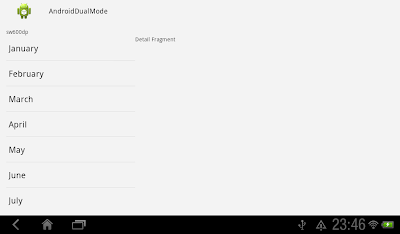In single pane mode run on phone, We have one pane displayed only. We have to switch fragment using Java code programm programmatically; if define in XML we cannot switch fragment later. We have a FrameLayout with id "phone_container" in layout xml. It will be used to determine if it's run on phone or tablet. We will load MyListFragment in onCreate() programmatically.
/res/layout/activity_main.xml
<LinearLayout xmlns:android="http://schemas.android.com/apk/res/android"
xmlns:tools="http://schemas.android.com/tools"
android:layout_width="match_parent"
android:layout_height="match_parent"
android:paddingBottom="@dimen/activity_vertical_margin"
android:paddingLeft="@dimen/activity_horizontal_margin"
android:paddingRight="@dimen/activity_horizontal_margin"
android:paddingTop="@dimen/activity_vertical_margin"
android:orientation="vertical"
tools:context=".MainActivity" >
<TextView
android:layout_width="wrap_content"
android:layout_height="wrap_content"
android:text="Normal" />
<FrameLayout
android:id="@+id/phone_container"
android:layout_width="match_parent"
android:layout_height="match_parent" >
</FrameLayout>
</LinearLayout>
In two pane mode, run on tablet. There are two fragments in layout. The fragments are loaded in XML.
/res/layout-sw600dp/activity_main.xml
<LinearLayout xmlns:android="http://schemas.android.com/apk/res/android"
xmlns:tools="http://schemas.android.com/tools"
android:layout_width="match_parent"
android:layout_height="match_parent"
android:paddingBottom="@dimen/activity_vertical_margin"
android:paddingLeft="@dimen/activity_horizontal_margin"
android:paddingRight="@dimen/activity_horizontal_margin"
android:paddingTop="@dimen/activity_vertical_margin"
android:orientation="vertical"
tools:context=".MainActivity" >
<TextView
android:layout_width="wrap_content"
android:layout_height="wrap_content"
android:text="sw600dp" />
<LinearLayout
android:layout_width="match_parent"
android:layout_height="match_parent"
android:orientation="horizontal">
<fragment
android:name="com.example.androiddualmode.MainActivity$MyListFragment"
android:id="@+id/list_fragment"
android:layout_height="match_parent"
android:layout_width="0dp"
android:layout_weight="1" />
<fragment
android:name="com.example.androiddualmode.MainActivity$MyDetailFragment"
android:id="@+id/detail_fragment"
android:layout_height="match_parent"
android:layout_width="0dp"
android:layout_weight="2" />
</LinearLayout>
</LinearLayout>
Create /res/layout/layout_detailfragment.xml, it's a simple layout in the MyDetailFragment.
<LinearLayout xmlns:android="http://schemas.android.com/apk/res/android"
xmlns:tools="http://schemas.android.com/tools"
android:layout_width="match_parent"
android:layout_height="match_parent"
android:orientation="vertical">
<TextView
android:id="@+id/title_detailfragment"
android:layout_width="wrap_content"
android:layout_height="wrap_content"
android:text="Detail Fragment"/>
</LinearLayout>
Modify MainActivity.java. Implement inner class of MyListFragment and MyDetailFragment.
package com.example.androiddualmode;
import android.os.Bundle;
import android.app.Activity;
import android.app.Fragment;
import android.app.FragmentTransaction;
import android.app.ListFragment;
import android.view.LayoutInflater;
import android.view.View;
import android.view.ViewGroup;
import android.widget.ArrayAdapter;
import android.widget.ListAdapter;
public class MainActivity extends Activity {
// if run on phone, isSinglePane = true
// if run on tablet, isSinglePane = false
boolean isSinglePane;
static String[] month ={
"January", "February", "March", "April",
"May", "June", "July", "August",
"September", "October", "November", "December"};
public static class MyListFragment extends ListFragment {
@Override
public void onActivityCreated(Bundle savedInstanceState) {
// TODO Auto-generated method stub
super.onActivityCreated(savedInstanceState);
ListAdapter myArrayAdapter =
new ArrayAdapter<String>(
getActivity(), android.R.layout.simple_list_item_1, month);
setListAdapter(myArrayAdapter);
}
}
public static class MyDetailFragment extends Fragment {
@Override
public View onCreateView(LayoutInflater inflater, ViewGroup container,
Bundle savedInstanceState) {
// TODO Auto-generated method stub
View view = inflater.inflate(R.layout.layout_detailfragment, null);
return view;
}
}
@Override
protected void onCreate(Bundle savedInstanceState) {
super.onCreate(savedInstanceState);
setContentView(R.layout.activity_main);
View v = findViewById(R.id.phone_container);
if(v == null){
//it's run on tablet
isSinglePane = false;
/*
* MyListFragment and MyDetailFragment have been loaded in XML,
* no need load.
*/
}else{
//it's run on phone
//Load MyListFragment programmatically
isSinglePane = true;
if(savedInstanceState == null){
//if's the first time created
MyListFragment myListFragment = new MyListFragment();
FragmentTransaction fragmentTransaction = getFragmentManager().beginTransaction();
fragmentTransaction.add(R.id.phone_container, myListFragment);
fragmentTransaction.commit();
}
}
}
}
Next:
- Handle onListItemClick() of ListFragment, to pass data between fragment


0 comments:
Post a Comment